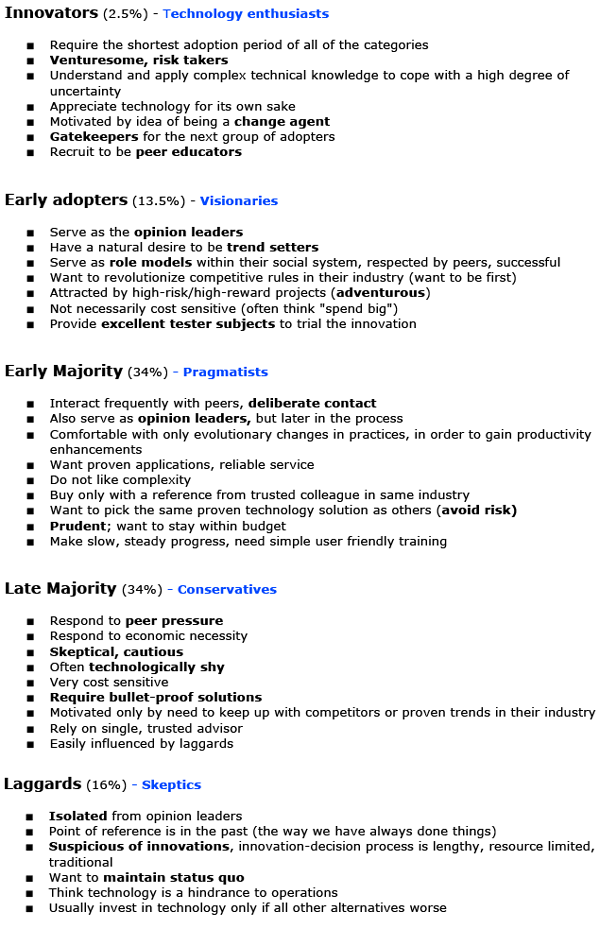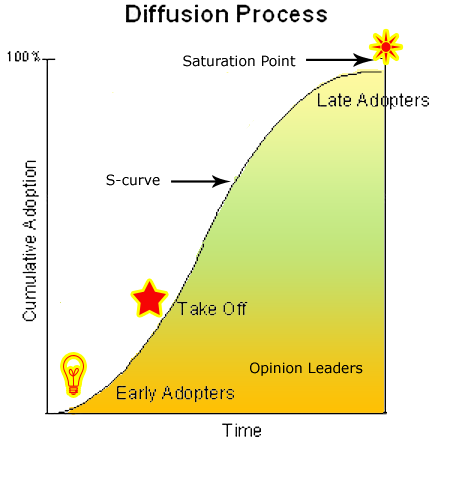Diffusion of Innovation Theory
Theory in Nursing Informatics Column
by June Kaminski, RN MSN PhD(c)
CJNI Editor in Chief
This feature is the first entry of our new column – Theory in Nursing Informatics written by our Editor in Chief, June Kaminski. Theory is an important aspect of nursing informatics – one that is often neglected due to time and context. In each column, a relevant theory will be presented and applied to various aspects of informatics in nursing practice, education, research and/or leadership.
OVERVIEW
The Diffusion of Innovation Theory was first discussed historically in 1903 by the French sociologist Gabriel Tarde (Toews, 2003) who plotted the original S-shaped diffusion curve, followed by Ryan and Gross (1943) who introduced the adopter categories that were later used in the current theory popularized by Everett Rogers. Katz (1957) is also credited for first introducing the notion of opinion leaders, opinion followers and how the media interacts to influence these two groups. The Diffusion of Innovation theory is often regarded as a valuable change model for guiding technological innovation where the innovation itself is modified and presented in ways that meet the needs across all levels of adopters. It also stresses the importance of communication and peer networking within the adoption process.
In simple terms, the diffusion of innovation refers to the process that occurs as people adopt a new idea, product, practice, philosophy, and so on. Rogers mapped out this process, stressing that in most cases, an initial few are open to the new idea and adopt its use. As these early innovators ‘spread the word’ more and more people become open to it which leads to the development of a critical mass. Over time, the innovative idea or product becomes diffused amongst the population until a saturation point is achieved. Rogers distinguished five categories of adopters of an innovation: innovators, early adopters, early majority, late majority, and laggards. Sometimes, a sixth group is added: non-adopters. The original five categories are illustrated in the bell-shaped curve image below. As you can see. Rogers estimated the percentage of each category, which in fact, are very similar to the proportions found in a normal bell-curve.

Figure 1: Diffusion of Innovation Adopter Categories
The five categories of adopters can be described in the context of technological innovation adoption and their influence on the innovative and adoption processes.

Within this theory, the goal is not to move people within the five adopter categories into another category, but to streamline the innovation to meet the needs of all five categories.

Figure 2: Diffusion Process
Peer Networks
The concept of peer networks is important in the Diffusion of Innovation theory. It is the critical mass achieved through the influence of innovators and early adopters who serve as opinion leaders that sparks the initial “take off” point in the innovation adoption process. These opinion leaders serve as valuable integral change agents who influence their peers through peer to peer communication, role modeling, and networking. This process works well within an organization or in society at large. A prime example is the use of social media networking to influence people through opinion leader tactics.
Five Stage Adoption Process
Knowledge or Awareness Stage
Individual is exposed to innovation but lacks complete information
Persuasion or Interest Stage
Individual becomes interested in the new idea and seeks additional information
Decision or Evaluation Stage
Individual mentally applies innovation to his present and anticipated future situation, and then decides whether or not to try it
Implementation or Trial Stage
Individual makes full use of innovation
Confirmation or Adoption Stage
Individual decides to continue the full use of innovation
Rogers (2003) explained that diffusion of innovation was the process by which an innovation is communicated through certain channels over time among members of a social system.
It is important to examine why some innovations are successful, while others never become widely accepted. Five distinct innovation characteristics have been identified by Rogers to explain this mystery. These characteristics include observability, relative advantage, compatibility, trialability, and complexity and according to Rogers, account for 49 to 87 per cent of the adoption variation seen across all categories of adopters. These characteristics also provide a valuable evaluation list for technology project leaders to apply when first considering innovative changes.
Innovation Characteristics
Observability
The degree to which the results of an innovation are visible to potential adopters
Relative Advantage
The degree to which the innovation is perceived to be superior to current practice
Compatibility
The degree to which the innovation is perceived to be consistent with socio-cultural values,
previous ideas, and/or perceived needs
Trialability
The degree to which the innovation can be experienced on a limited basis
Complexity
The degree to which an innovation is difficult to use or understand, its simplicity.
Re-invention
Re-invention is another important consideration. This is basically referring to the degree that an innovation is changed or modified as the adoption and implementation process is enacted. If an innovation is amenable to re-invention as dictated by the needs of the five adopter categories, , the more versatile and adaptable it is seen to be, and the more likely it will be fully adopted to a healthy saturation point.
Communication Channels
Communication Channels refers to the rate and degree that people talk about and spread the news about the innovations. Two major communication channels were described by Rogers:
Mass Media Channels
These are effective in creating knowledge about the innovation, for instance system related videos or DVDs, or television commercials within the mainstream media
Interpersonal Channels
Person to person communication is very effective in changing people’s attitudes about the innovation which ultimately influences their decision to accept or reject the innovation. Peer subjective evaluations of an innovation are very influential.
Time
Time is involved in three distinct dimensions of the innovation process
Innovation Adoption Process
– including first knowledge of the innovation through to final acceptance or rejection of its utility and ultimate implementation, as discussed earlier.
Innovation Adopter Categories
– time is also critical within the five adopter categories and how they influence one another to support full saturation of the innovation.
Rate of Adoption
– time is also involved when looking at the ultimate rate of adoption, say within an organization, from start to finish, and how many people of the total population have adopted the innovation. This rate of adoption is influenced by the innovation characteristics introduced above.
Social System
The fourth and final dimension refers to the groups of people involved in the innovation adoption process. This could be employees at an institution, a neighborhood or a whole nation.
Conclusion
The Diffusion of Innovation theory is a very important theory that can serve administrators, information technologists, nursing informatics experts, and change agents well. The theory also benefits the targets of change, since respect and consideration for all involved stakeholders is intertwined with robust strategies for implementing innovative change. The theory fits nursing informatics well, and provides a scaffold for planning informatics related innovations.
REFERENCES
Katz, E. (1957). The Two-Step Flow of Communication: an Up-To Date Report on a Hypothesis. The Public Opinion Quarterly, 21 (1). pp. 61-78.
Rogers, E. (2003). Diffusion of Innovations. Fifth edition. Free Press: New York.
Ryan & Gross (1943), The Diffusion of Hybrid Seed Corn in Two Iowa Communities, Rural Sociology 8 (March): 15
Toews, D. (2003) The New Tarde: Sociology after the End of the Social Theory Culture & Society 20 (5), 81-98.
CITATION
Kaminski, J. (Spring 2011).Diffusion of Innovation Theory Canadian Journal of Nursing Informatics, 6(2). Theory in Nursing Informatics Column. https://cjni.net/journal/?p=1444






